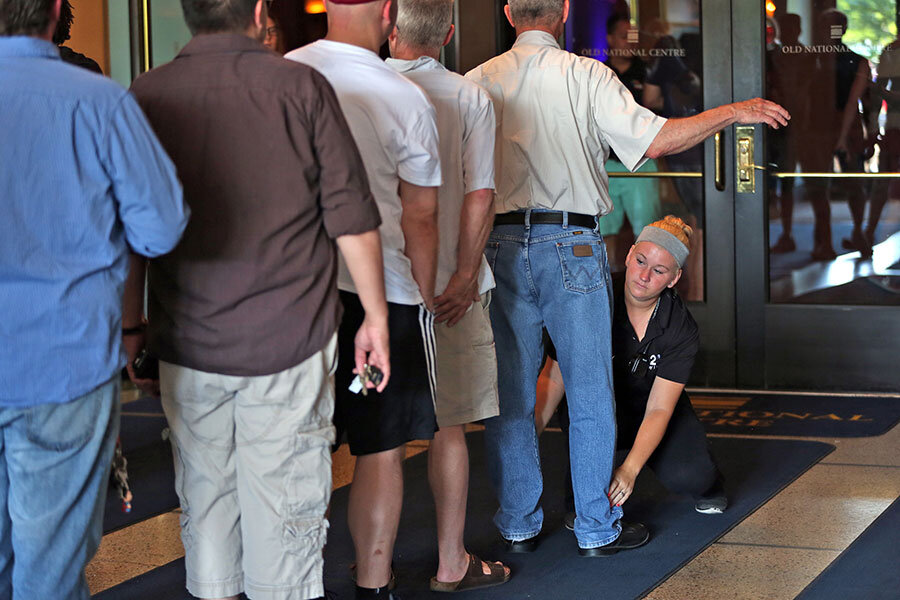How Orlando terror attack fits a trend
Loading...
The details of Sunday’s mass shooting in Florida are incomplete enough that President Obama would only describe it Sunday as “an act of terror and an act of hate.” But in many respects it followed a pattern of mass murder that is increasingly favored by terrorist organizations and their sympathizers.
A lone gunman entered a popular gay nightclub in Orlando early Sunday morning with a handgun, an assault rifle and, reportedly, an explosive device. Three hours later, 50 people were dead, including the shooter, and 53 were injured, making the event the worst mass shooting in modern United States history.
It is still unclear if the gunman, Omar Mateen of Fort Pierce, Fla., was under direction from a specific terrorist organization or simply inspired by one – he called 911 moments before the attack and pledged his allegiance to the Islamic State. But his methods mirror recent terror attacks committed by organizations and “lone wolves.”
Specifically, terrorists are increasingly favoring using guns instead of explosives, experts say, and choosing “soft targets” – confined areas crowded with civilians like concert halls, clubs, shopping malls or sports events – instead of “hard targets” like military or government facilities. Soft targets typically have weak security, and they can have an impact far beyond the attack itself given that they happen in everyday places.
Moreover, attacks on soft targets can be difficult to prevent, experts say.
The Islamic State appeared to encourage attacks on soft targets in one cleric's message at the beginning of the Muslim holy month of Ramadan.
"We have been informed that some of you cannot carry out attacks because they are unable to attack military targets and they find it difficult to attack the so-called civilians," said ISIS spokesman Abu Muhammad Al-Adnani in an audio statement released May 21. "[A potential attacker] then would abort [his plan] since he was unsure of the permissibility and legitimacy [of attacking civilian targets]. Let it be known to you that [spilling] the blood [of people living] in the country of the crusaders and combatants is not forbidden. There is no such thing as innocents [there]."
Recent attacks point to the proliferation of these kinds of methods.
- In the Paris attacks, which were actually masterminded by the Islamic State, a handful of attackers coordinated shootings and bombings at a restaurant, a nightclub, and outside a soccer stadium, ultimately killing 129 people and wounding 350.
- Those attacks were themselves copied from similar attacks in Mumbai in November 2008, in which 10 Islamist militants carried out shootings and bombings before taking hostages in two hotels in an crisis lasting four days. In all, 166 people died.
- Two bombings at the Boston Marathon in 2013 killed three people and wounded more than 260.
- Last December, two ISIS-inspired shooters killed 14 people and injured 22 in San Bernardino, Calif.
Adding to the challenge of preventing these attacks is that perpetrators are increasingly turning to guns and small arms instead of explosives, experts say.
“The big worry is that more people will decide to attack using handguns and rifles and not focus on bombs,” William McCants, author of “The ISIS Apocalypse,” told The Washington Post.
“That sounds counterintuitive,” he added, “but when you’re building the bomb, there’s usually a lot of people involved and you have to buy material that the government has monitored, so it’s easier to identify and disrupt a plot that involves a bomb.”
True, Mr. Mateen had been interviewed by the Federal Bureau of Investigation in 2013 and 2014, but “the interviews turned out to be inconclusive, so there was nothing to keep the investigation going,” FBI Special Agent Ronald Hopper told reporters on Sunday.
Mateen was not under investigation or surveillance at the time of the shooting.
Intelligence and law enforcement agencies only have the resources to follow so many leads, which could create a temptation to add layers of security to everyday life, or for citizens to withdraw from everyday life.
This is exactly the debate terrorist organizations hope to incite through these attacks, said US Secretary of State John Kerry after the Paris attacks.
“The idea is to make us believe that we are always going to be in such grave and imminent danger that we actually have to stop what we’re doing and change our choices and change our way of life,” he said.
President Obama challenged Americans to rise above that on Sunday, calling on them to “not give in to fear.”
“In the face of hate and violence we will love one another, we will not give in to fear or turn against each other,” he said. “Instead we will stand united as Americans to protect our people, defend our nation, and take action against those who threaten us.”






